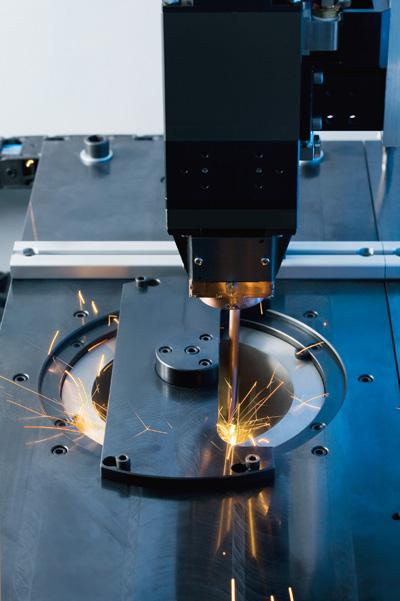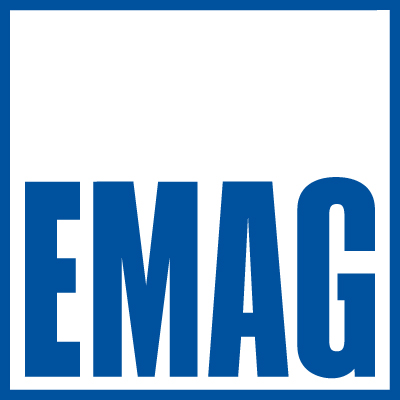
From dual-clutch transmissions to the classic differential, modern transmission technology is a pivotal research sector in the automotive industry where designers optimize the functionality of gearwheels with new materials and altered geometries. These gearwheels are also required in ever larger quantities as the number of speed-gears in many passenger cars continues to increase. Laser welding is one innovation promoting effective processes and EMAG capitalizes on their knowledge in the production of transmission components with ELC series of laser welding machines that offer integrated solutions for processes with high output rates.
A typical transmission component presents many challenges. Even a small wheel with an integrated synchronous gear represents a relatively complex design and to manufacture it efficiently and at the highest precision calls for two different parts to be produced separately and subsequently joined in a welding and joining process.
"It is at this point in modern transmission manufacture that laser welding comes into play," explains Dr Andreas Mootz, Managing Director of EMAG Automation. "The process allows manufacturers to concentrate a carefully dosed amount of the energy emitted by a laser beam on the welding point, minimizing possible warping yet still achieving high welding speeds."
The EMAG welding process uses solid-state lasers with outstanding energy efficiency. Whereas a classic carbon dioxide laser achieves an efficiency factor of just eight percent, EMAG laser welding technology boasts an efficiency factor of approximately 20 percent. Noticeably less power is used to achieve the same optical performance with solid-state lasers, massively reducing energy costs in production.
Production sequences are fully integrated on the ELC system, beginning with a work spindle that uses the pick-up principle to load itself. Components are then clamped and pressed together in the joining press. The clamping technology used ensures highly accurate positioning of the components, providing ideal conditions for the welding process. The design of the stationary optic ensures operating safety and optimal stability of both the machine and welding process. Depending on workpiece or material, the components can be induction-preheated prior to the welding process and brushed thereafter. Regardless of what is required, the process is completed in a single setup. The complete joining and welding process for a gearwheel takes just 12 seconds, while the components for a differential are finish-welded within 40 seconds.
Differential housings clearly show the possibilities laser welding technology opens in vehicle production. For some time now automotive companies have been replacing the screw-type connection between the differential housing and crown gear with a welding seam, resulting in a reduced material cost while the weight of the assembly falls by approximately 1.2 kg. "These kinds of savings are a significant advancement in light-weight construction within the automotive industry," explains Dr Mootz.
With over 50 ELC systems sold in the last decade, all the leading automobile manufacturers integrate them, making EMAG the world leader in solid-state laser systems for the production of transmission and powertrain components. "That we have a large reservoir of know-how in the manufacture of these components at our disposal is essential. We know the whole manufacturing process, from turning and grinding to welding and the concluding ultrasound testing process," emphasizes Dr Mootz. "We can develop and construct the complete process. This massively simplifies the planning of new production sites and the expansion of existing ones."
It is not only the successful dual-clutch transmission that creates the increasing demand for gears. Conventional transmission systems, too, tend to have more speed gears, as this reduces fuel consumption and improves the driving comfort.
"We offer a well proven welding technology that provides energy-savings, a high-precision manufacturing process and, at the same time, helps to advance light-weight construction and reduce production costs. This is, no doubt, a very successful and persuasive combination," concludes Dr Mootz.
Contact Details
Related Glossary Terms
- grinding
grinding
Machining operation in which material is removed from the workpiece by a powered abrasive wheel, stone, belt, paste, sheet, compound, slurry, etc. Takes various forms: surface grinding (creates flat and/or squared surfaces); cylindrical grinding (for external cylindrical and tapered shapes, fillets, undercuts, etc.); centerless grinding; chamfering; thread and form grinding; tool and cutter grinding; offhand grinding; lapping and polishing (grinding with extremely fine grits to create ultrasmooth surfaces); honing; and disc grinding.
- turning
turning
Workpiece is held in a chuck, mounted on a face plate or secured between centers and rotated while a cutting tool, normally a single-point tool, is fed into it along its periphery or across its end or face. Takes the form of straight turning (cutting along the periphery of the workpiece); taper turning (creating a taper); step turning (turning different-size diameters on the same work); chamfering (beveling an edge or shoulder); facing (cutting on an end); turning threads (usually external but can be internal); roughing (high-volume metal removal); and finishing (final light cuts). Performed on lathes, turning centers, chucking machines, automatic screw machines and similar machines.

